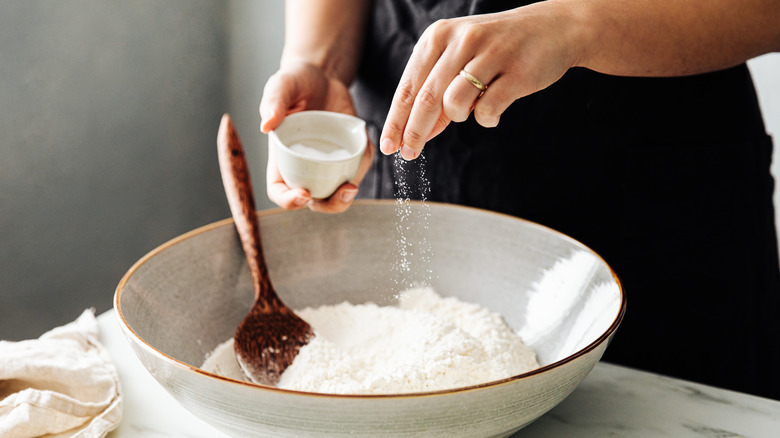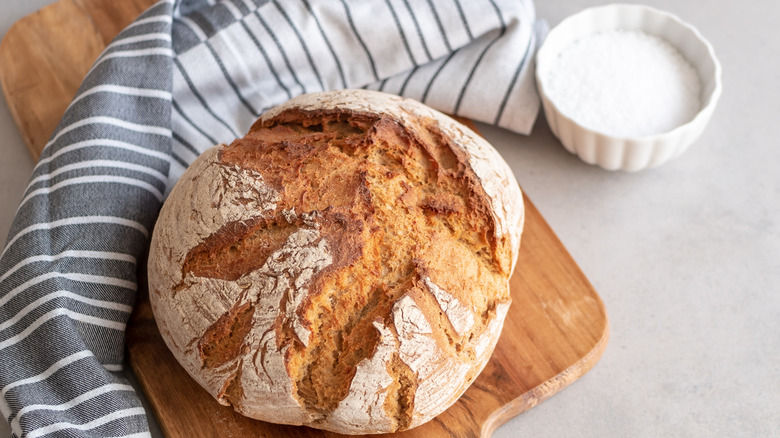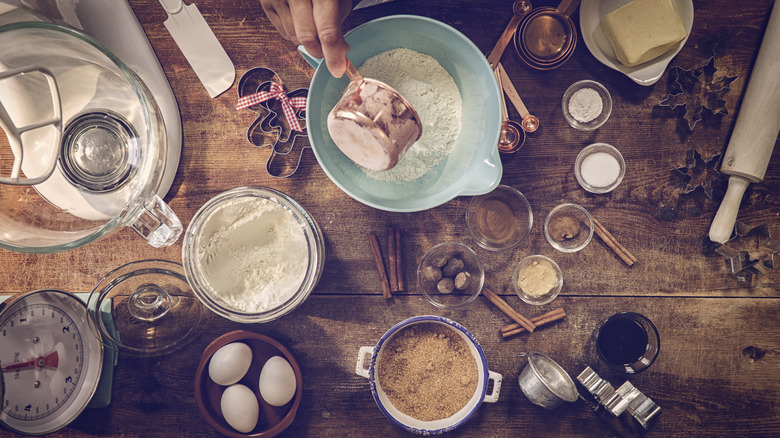Why Reducing Salt In Baking Is Rarely A Good Idea
Being aware of sodium intake is important, but flavorful homemade food is probably not an issue. Health-minded people may choose to reduce salt in savory cooking, and there are many reasonable ways to do so without making big sacrifices on flavor. However, when baking, reducing salt is largely unnecessary. Not only is the amount of salt typically added to baked goods a tiny proportion, it is also crucial for a great final product.
Consuming too much sodium, typically in the form of added salt, does contribute to elevated blood pressure and increase risk of stroke and heart attack. The vast majority of people in the United States are consuming far more than the recommended 2,300 milligrams of sodium. Depending on which type of salt, that's about one teaspoon. This may come as a shock to salt evangelists, otherwise known as people that think food should taste good, but don't relegate yourself to a dull culinary existence just yet. The major offenders are processed foods with hidden salt used as preservatives. Foods like processed cheeses and meats, snacks, crackers, cereal, seasoning blends, and salad dressings, as well as foods prepared in restaurants, are loaded with salt even though they might not taste overly salty.
The well-seasoned food you make at home, however, is not as much of an issue because you are aware of exactly how much you are adding. In baked goods, salt adds flavor, depth, and balance, and even helps create a desirable texture.
Why does bread need salt?
The right amount of salt slows the fermentation by dehydrating the yeast. Without salt, yeast eats sugar with abandon. The bread rises too quickly making a sticky dough that is challenging to handle and prone to collapse during baking. The longer rise time also allows for proper gluten development. Gas bubbles from carbon dioxide are created during the rise, and strong gluten strands create the netting that stops those gas bubbles from escaping giving good bread its characteristic texture — light and airy, but pleasantly chewy. Without enough salt, bread dough can become a floppy mess, impossible to shape into a loaf. The glistening browned crust of a loaf of bread comes from sugars in the dough caramelizing. Without salt slowing the process, the yeast consumes too much of the sugar, and the resulting crust is lackluster and pale. Slowly consuming those sugars also creates acid which yields that pleasant tangy flavor.
After testing, King Arthur Baking found that bakers looking to reduce salt could do so by about half, but should try to maintain a percentage of 1.8 – 2% salt compared to the weight of the flour. Despite changes in flavor and texture, the end product will still be good enough to eat. However, since there is typically less than a teaspoon of salt in a whole loaf and only a couple of slices are consumed at a time, there isn't much of a reason to reduce salt when making bread.
What does salt do for flavor in baked goods?
Salt makes foods taste more like themselves. This simple addition can turn something from tasteless to stellar, which makes sense for meats and vegetables, but also applies to sweets. Consider how bland many of the base ingredients are baked goods. "Just as you'd never leave flour, butter, eggs, or cream unseasoned in a savory dish, so should you never leave them unseasoned in a dessert," writes Samin Nosrat in her book "Salt, Fat, Acid, Heat: Mastering the Elements of Good Cooking."
If you have ever had a dessert that tasted flat, one-note, or even overly sweet, it may be because it was not properly salted. Salt helps tame bitter tastes, like from cocoa and coffee, and balances sweetness. Tart flavors like citrus or berries pop with the right amount of salt, and scents like from warm spices or floral ingredients are made more aromatic.
Just a pinch is enough to make a huge difference. Like bread, that little bit of salt is being distributed over several servings, so the amount being consumed at one time isn't much, but the effect on flavor is significant.



